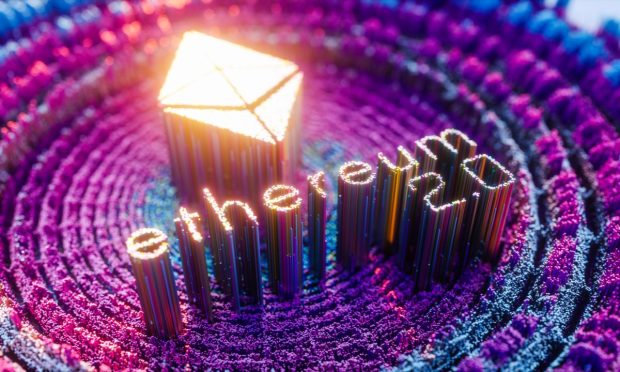Ethereum Gets Closer to an Eco-Friendlier Version 2.0, but Next-Gen Scalability Still Delayed

No. 2 blockchain Ethereum took a big step toward its greener future this week with the launch of a “shadow” version of the forthcoming Ethereum 2.0.
But that was tempered by news of more delays that will see the most important part of the second generation of the smart-contract blockchain — scalability — pushed back to at least 2023.
See also: PYMNTS Blockchain Series: What Is Ethereum? The Blockchain That Moved Crypto Beyond Currency
The blockchain on which almost everything except straight currency replacements like bitcoin and litecoin run, Ethereum smart contracts are the workhorse everything from supply chain management to non-fungible tokens (NFTs) to decentralized finance (DeFi) is built on.
On April 11, the first Ethereum 2.0 Mainnet Shadow Fork went live. In plain English, that means a test version of the Ethereum 2.0 blockchain that could eventually be merged with the final product is up and running. That allows developers to stress test it.
The latest estimate is early fall for Ethereum 2.0 to go live.
But there are two parts to Ethereum 2.0. The first and highest profile is to make it greener. But the second part, known as “sharding,” is necessary to make it faster.
The long delays have allowed a number of so-called “Ethereum killer” blockchains — several created by early Ethereum developers — to get the jump on the original.
Read the PYMNTS Blockchain Series:
What’s Algorand? The Blockchain Securing Transactions by Spreading the Wealth
What Is BNB Chain and Why Isn’t It Binance Anymore?
What is Polkadot? The most ambitious of the Ethereum Killers
What is Polygon? An Ethereum Killer Hedges Its Bets
Aimed first and foremost at stealing away old DeFi projects and attracting new ones, these projects have faster, cleaner blockchains up and running and pinching projects already. With another year to undercut Ethereum, the No. 2 blockchain may well lose its dominant position.
Slow Progress
Begun in 2016, the much-delayed Ethereum 2.0 project was conceived almost as soon as the blockchain launched in July 2015, as it was clear from the beginning that its top speed of 12 to 14 transactions per second (TPS) would never be enough to compete with Visa’s top speed, which has since reached 65,000 TPS.
Since then, it acquired a second, almost equally important purpose: Shifting from bitcoin’s staggeringly energy intensive and polluting proof-of-work (PoW) consensus mechanism to proof of stake (PoS), which uses minimal power and will also allow it to scale to 100,000 TPS.
Read more: PYMNTS Crypto Basics Series: What’s a Consensus Mechanism and Why Is It Destroying the Planet?
Until next-generation scalability can be reached, Ethereum will effectively remain not ready for prime time — and just as a payments tool. The blockchain is badly clogged by DeFi and the NFTs that are used to distribute art, music, video and staggeringly overpriced CryptoPunk and Bored Ape avatars — as well as to virtual goods that are both the building blocks and commercial core of the metaverse.
See also: What’s a Metaverse, and Why is One Having a Fashion Show?
As a result, not only can transactions be delayed, they are staggeringly expensive — with basic transaction fees (known as “gas”) generally in the $3 to $5 range, but capable of spiking to 10x that. And complex ones like minting NFTs can run $75 and up.
Killer Speed
The first “merge” that Monday’s Shadow Fork is leading up to will be the changeover to PoS, cutting Ethereum’s country-sized energy requirements by 95%.
That’s important as the current PoW process is increasingly attracting attacks from environmentalists, politicians — there was just a strong and barely defeated push in the EU Parliament to ban PoW outright — and even investors concerned about their reputations.
Also read: Can Proof-of-Stake Solve Crypto’s ESG Problem?
However, simply moving to PoS alone won’t give Ethereum 2.0 the scalability it needs.
For that, the Ethereum Foundation and its development community is turning to sharding or splitting the entire network up into smaller pieces to make it faster.
See: Ethereum 2.0 Will Not Be Any Faster, Vitalik Buterin Said. But It Will Still Scale Massively
Which is great, but it’s far more complex than the Layer2 solutions like bitcoin’s Lightning and many of the Ethereum killers use. These work by taking the bulk of the transaction processing work off the main chain and putting it onto another Layer2 chain that simply sends bundle of transaction results to the main chain. Others create many secondary chains — some even one for each project — that do the same thing.
If Ethereum 2.0 can really get fully launched by 2023 — green and scalable — it’ll probably hold onto its dominant position. But don’t hold your breath.
